The Tribo-Fatigue Damage Transition and Mapping for Wheel Material under Rolling-Sliding Contact Condition
Abstract
1. Introduction
2. Materials and Methods
3. Results
3.1. Wear Rate and Wear Regime Map
3.2. Surface Damage Behavior and Tribo-Fatigue Damage Transition Map
4. Discussion
5. Conclusions
- The wear rate of the wheel specimen increases as the contact pressure and tangential force increases. According to wear rate of the wheel specimen under each testing condition, the wear mechanism map was established and divided into three regions of slight wear, severe wear, and destructive wear.
- The tribo-fatigue damage map of wheel material was established and divided into slight fatigue damage, fatigue damage, and severe fatigue damage regions, based on the analysis of the surface damage morphology and average crack length of the wheel roller under each experiment condition. In the slight fatigue damage region, the damage mechanism is slight fatigue damage and spalling; that of the fatigue damage region is dominated by surface fatigue cracks and peeling; and that of severe fatigue damage region is mainly severe surface fatigue cracks and peeling.
- The formation process of spalling damage was summarized based on the analysis of the test results, which was similar to the observations of two typical surface fracture types (pitting and wear by spalling) in rolling fatigue tests by Sosnovskiy [22]. Fatigue cracks are mainly initiated on the wheel surface. In the case of a small tangential force, some cracks propagate into material but fractured under cyclic rolling contact, and/or grow into inner material to a certain depth and then turn toward the surface to form material flaking. Under a large tangential force, some cracks always propagate parallel to the wheel roller surface.
Author Contributions
Funding
Conflicts of Interest
References
- Butini, E.; Marini, L.; Meacci, M.; Meli, E.; Rindi, A.; Zhao, X.J.; Wang, W.J. An innovative model for the prediction of wheel-Rail wear and rolling contact fatigue. Wear 2019, 436–437, 203025. [Google Scholar] [CrossRef]
- Faccoli, M.; Petrogalli, C.; Lancini, M.; Ghidini, A.; Mazzù, A. Rolling contact fatigue and wear behavior of high-performance railway wheel steels under various rolling-sliding contact conditions. J. Mater. Eng. Perform. 2017, 26, 3271–3284. [Google Scholar] [CrossRef]
- Zhu, Y.; Wang, W.J.; Lewis, R.; Yan, W.Y.; Lewis, S.R.; Ding, H.H. A Review on Wear Between Railway Wheels and Rails Under Environmental Conditions. ASME J. Tribol. 2019, 141, 120801. [Google Scholar] [CrossRef]
- Ekberg, A.; Akesson, B.; Kabo, E. Wheel/rail rolling contact fatigue-probe, predict, prevent. Wear 2014, 314, 2–12. [Google Scholar] [CrossRef]
- Ueda, M.; Matsuda, K. Effects of carbon content and hardness on rolling contact fatigue resistance in heavily loaded pearlitic rail steels. Wear 2019. [Google Scholar] [CrossRef]
- Lewis, R.; Christoforou, P.; Wang, W.J.; Beagles, A.; Burstow, M.; Lewis, S.R. Investigation of the influence of rail hardness on the wear of rail and wheel materials under dry conditions (ICRI wear mapping project). Wear 2019, 430–431, 383–392. [Google Scholar] [CrossRef]
- Hannes, D.; Alfredsson, B. Numerical investigation of the spall opening angle of surface initiated rolling contact fatigue. Eng. Fract. Mech. 2014, 131, 538–556. [Google Scholar] [CrossRef]
- Dahlberg, J.; Alfredsson, B. Influence of a single axisymmetric asperity on surface stresses during dry rolling contact. Int. J. Fatigue 2007, 29, 909–921. [Google Scholar] [CrossRef]
- Kato, T.; Sugeta, A.; Nakayama, E. Investigation of influence of white layer geometry on spalling property in railway wheel steel. Wear 2011, 271, 400–407. [Google Scholar] [CrossRef]
- Makino, T.; Yamamoto, M.; Fujimura, T. Effect of material on spalling properties of railroad wheels. Wear 2002, 253, 284–290. [Google Scholar] [CrossRef]
- Carroll, R.I.; Beynon, J.H. Rolling contact fatigue of white etching layer: Part 1: Crack morphology. Wear 2007, 262, 1253–1266. [Google Scholar] [CrossRef]
- Zhu, Y.; Sundh, J.; Olofsson, U. A tribological view of wheel-rail wear maps. Int. J. Railw. Technol. 2013, 2, 79–91. [Google Scholar] [CrossRef]
- He, C.G.; Huang, Y.B.; Ma, L.; Guo, J.; Wang, W.J.; Liu, Q.Y.; Zhu, M.H. Experimental investigation on the effect of tangential force on wear and rolling contact fatigue behaviors of wheel material. Tribol. Int. 2015, 92, 307–316. [Google Scholar] [CrossRef]
- Seo, J.W.; Jun, H.K.; Kwon, S.J.; Lee, D.H. Rolling contact fatigue and wear of two different rail steels under rolling-sliding contact. Int. J. Fatigue 2016, 83, 184–194. [Google Scholar] [CrossRef]
- Zhou, Y.; Peng, J.F.; Wang, W.J.; Jin, X.S.; Zhu, M.H. Slipping effect on rolling contact wear and damage behaviors of pearlitic steels. Wear 2016, 362–363, 78–86. [Google Scholar] [CrossRef]
- Ma, L.; He, C.G.; Zhao, X.J.; Guo, J.; Zhu, Y.; Wang, W.J.; Liu, Q.Y.; Jin, X.S. Study on wear and rolling contact fatigue behaviors of wheel/rail materials under different slip ratio conditions. Wear 2016, 366–367, 13–26. [Google Scholar] [CrossRef]
- Christoforou, P.; Fletcher, D.I.; Lewis, R. Benchmarking of premium rail material wear. Wear 2019, 436–437, 202990. [Google Scholar] [CrossRef]
- Lewis, R.; Olofsson, U. Mapping rail wear regimes and transitions. Wear 2004, 257, 721–729. [Google Scholar] [CrossRef]
- Li, Z.L.; Kalker, J.J. Simulation of severe wheel-rail wear. In Proceedings of the 6th International Conference on Computer Aided Design, Manufacture and Operation in the Railway and Other Advanced Mass Transit Systems, Palo Alto, CA, USA, 4–6 November 1998; pp. 393–402. [Google Scholar]
- Braghin, F.; Lewis, R.; Dwyer-Joyce, R.S.; Bruni, S. A mathematical model to predict railway wheel profile evolution due to wear. Wear 2006, 261, 1253–1264. [Google Scholar] [CrossRef]
- Wang, W.J.; Lewis, R.; Yang, B.; Guo, L.C.; Liu, Q.Y.; Zhu, M.H. Wear and damage transitions of wheel and rail materials under various contact conditions. Wear 2016, 362, 146–152. [Google Scholar] [CrossRef]
- Sosnovskiy, L.A. Tribo-Fatigue: Wear-Fatigue Damage and its Prediction; Springer: Berlin, Germany, 2005; pp. 90–92. [Google Scholar]
- Basaran, C.; Nie, S. An irreversible thermodynamic theory for damage mechanics of solids. Int. J. Damage Mech. 2004, 13, 205–224. [Google Scholar] [CrossRef]
- Yao, W.; Basaran, C. Computational damage mechanics of electromigration and thermomigration. J. Appl. Phys. 2013, 114, 103708. [Google Scholar] [CrossRef]
- Wang, J.; Yao, Y. An Entropy Based Low-Cycle Fatigue Life Prediction Model for Solder Materials. Entropy 2017, 19, 503. [Google Scholar] [CrossRef]
- Sosnovskiy, L.A.; Sherbakov, S.S. Mechanothermodynamic entropy and analysis of damage state of complex systems. Entropy 2016, 18, 268. [Google Scholar] [CrossRef]
- Sosnovskiy, L.A.; Sherbakov, S.S. A model of mechanothermodynamic entropy in tribology. Entropy 2017, 19, 115. [Google Scholar] [CrossRef]
- Lewis, R.; Dwyer-Joyce, R.S.; Olofsson, U.; Pombo, J.; Ambrósio, J.; Pereira, M.; Ariaudo, C.; Kuka, N. Mapping railway wheel material wear mechanisms and transitions. Proc. Inst. Mech. Eng. Part F J. Rail Rapid Transit 2010, 224, 125–137. [Google Scholar] [CrossRef]
- Lewis, R.; Magel, E.; Wang, W.J.; Olofsson, U.; Lewis, S.; Slatter, T.; Beagles, A. Towards a standard approach for the wear testing of wheel and rail materials. Proc. Inst. Mech. Eng. Part F J. Rail Rapid Transit 2017, 231, 760–774. [Google Scholar] [CrossRef]
- Stone, D.H.; Moyar, G.J. Wheel shelling and spalling—An interpretive review. Rail Transp. 1989, 5, 9–30. [Google Scholar]
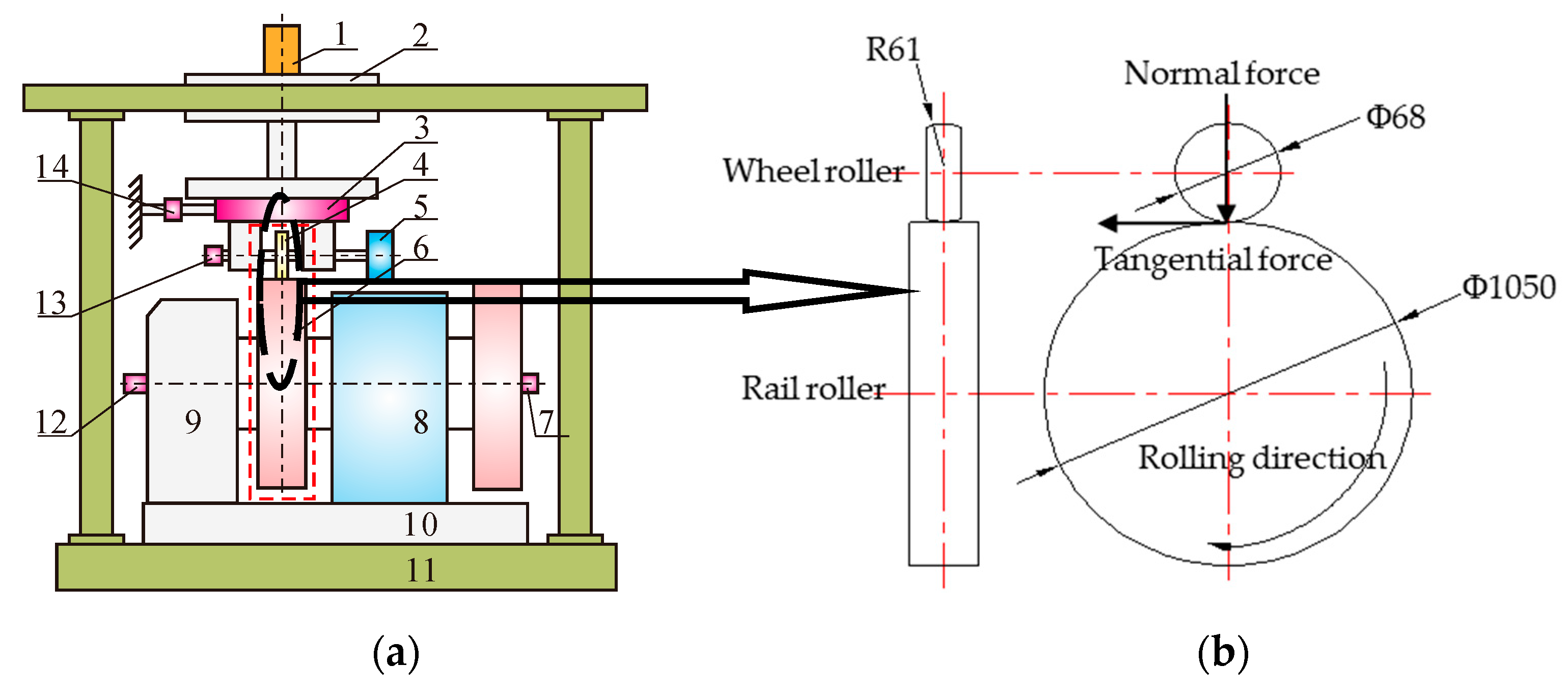
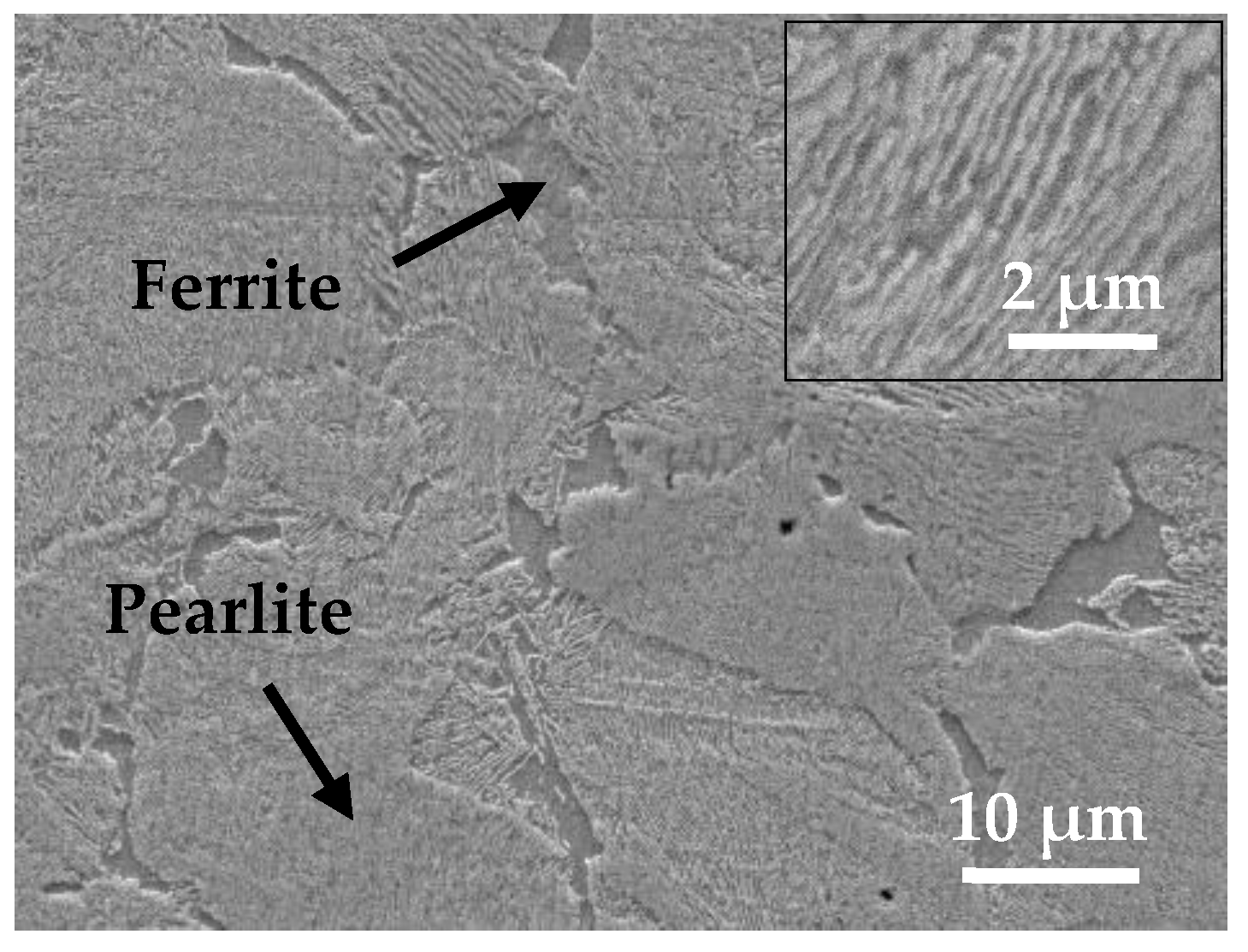
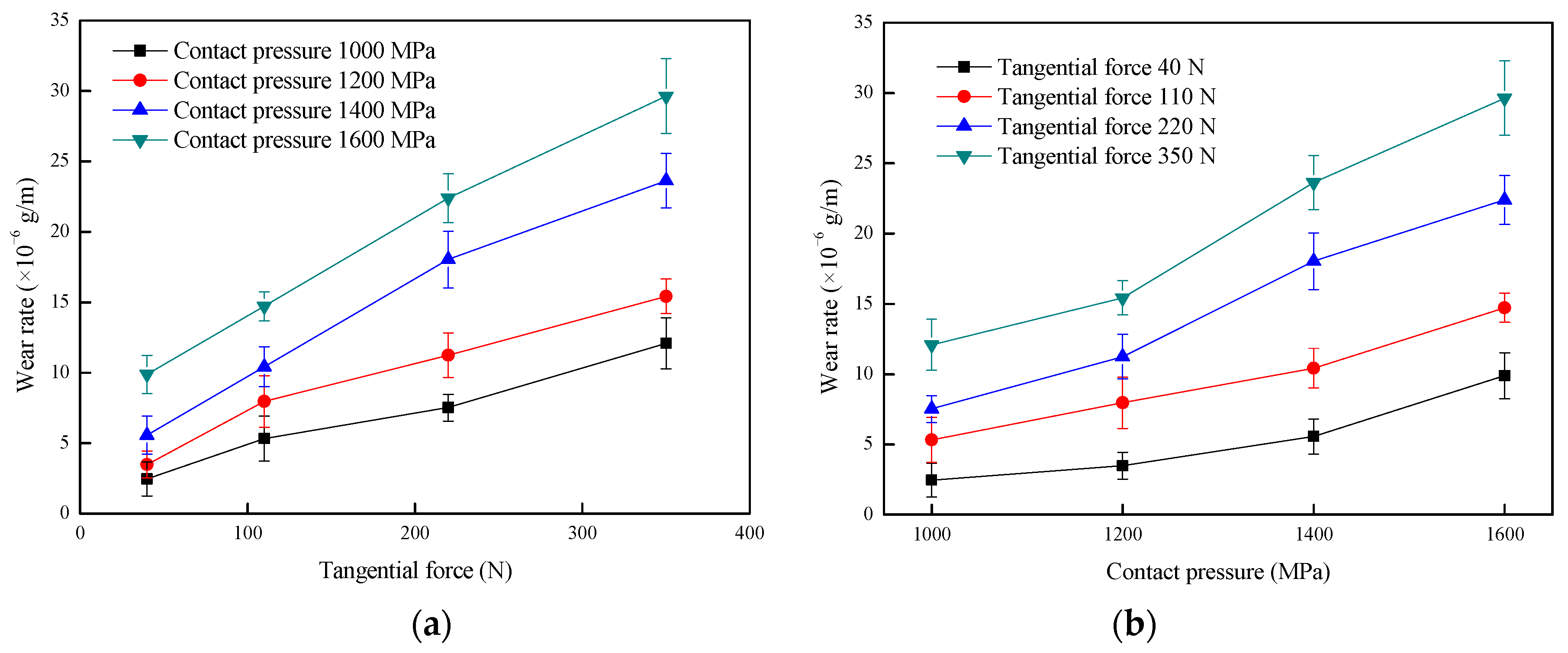



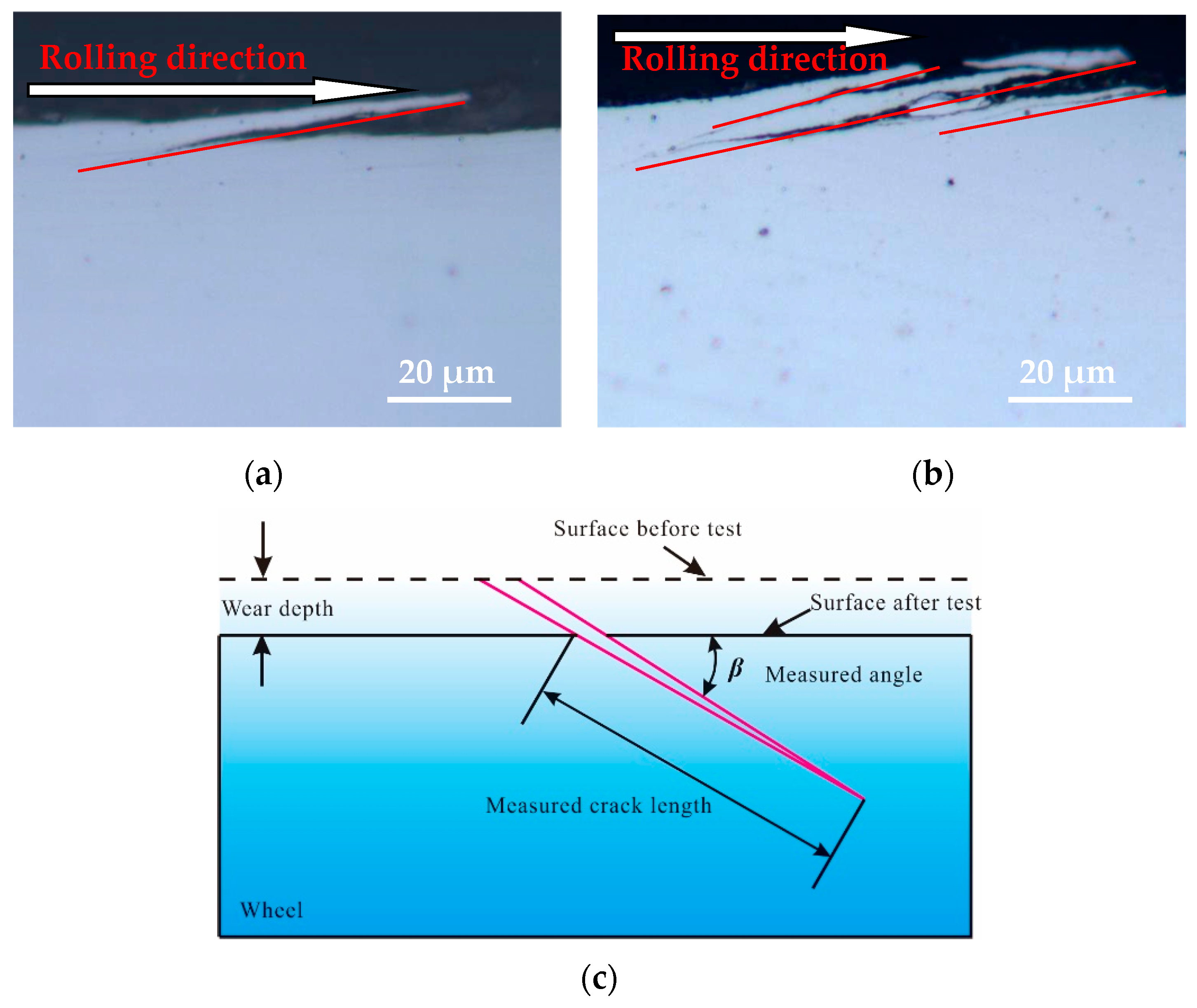
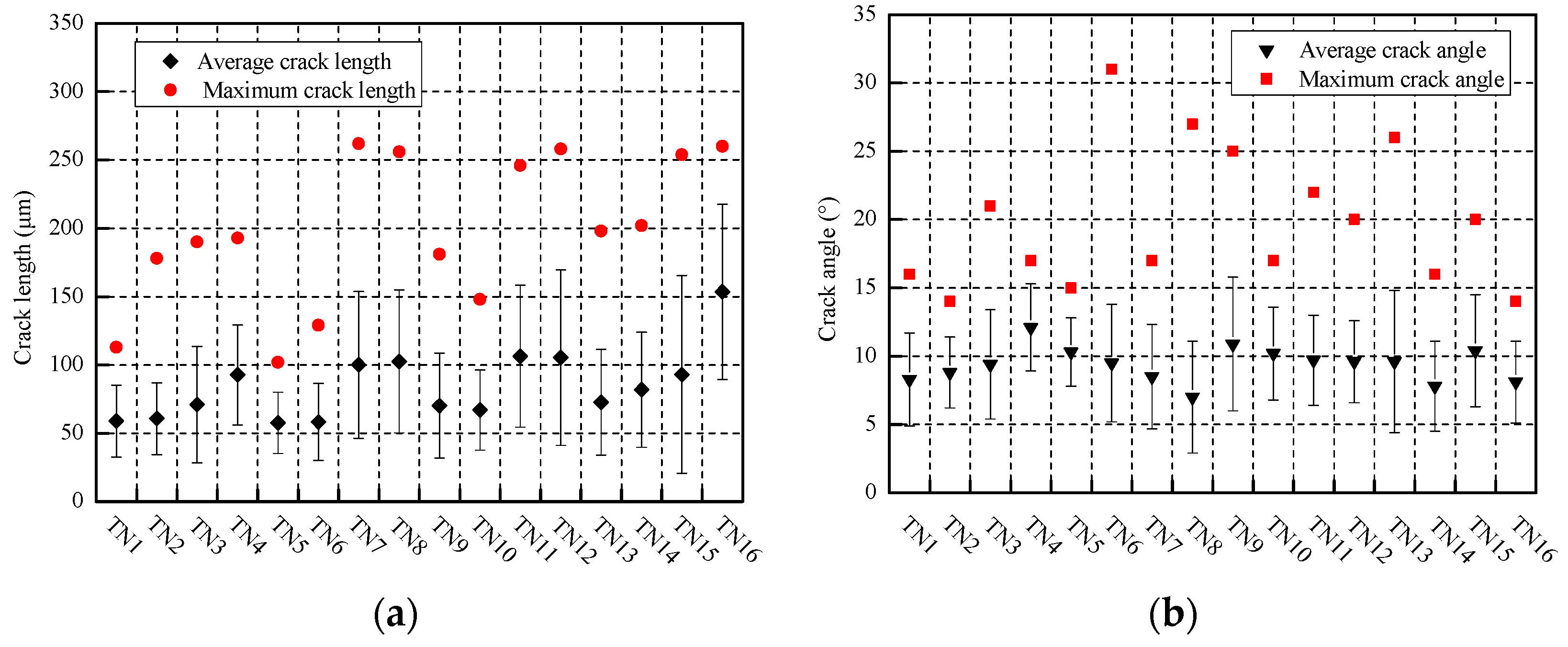
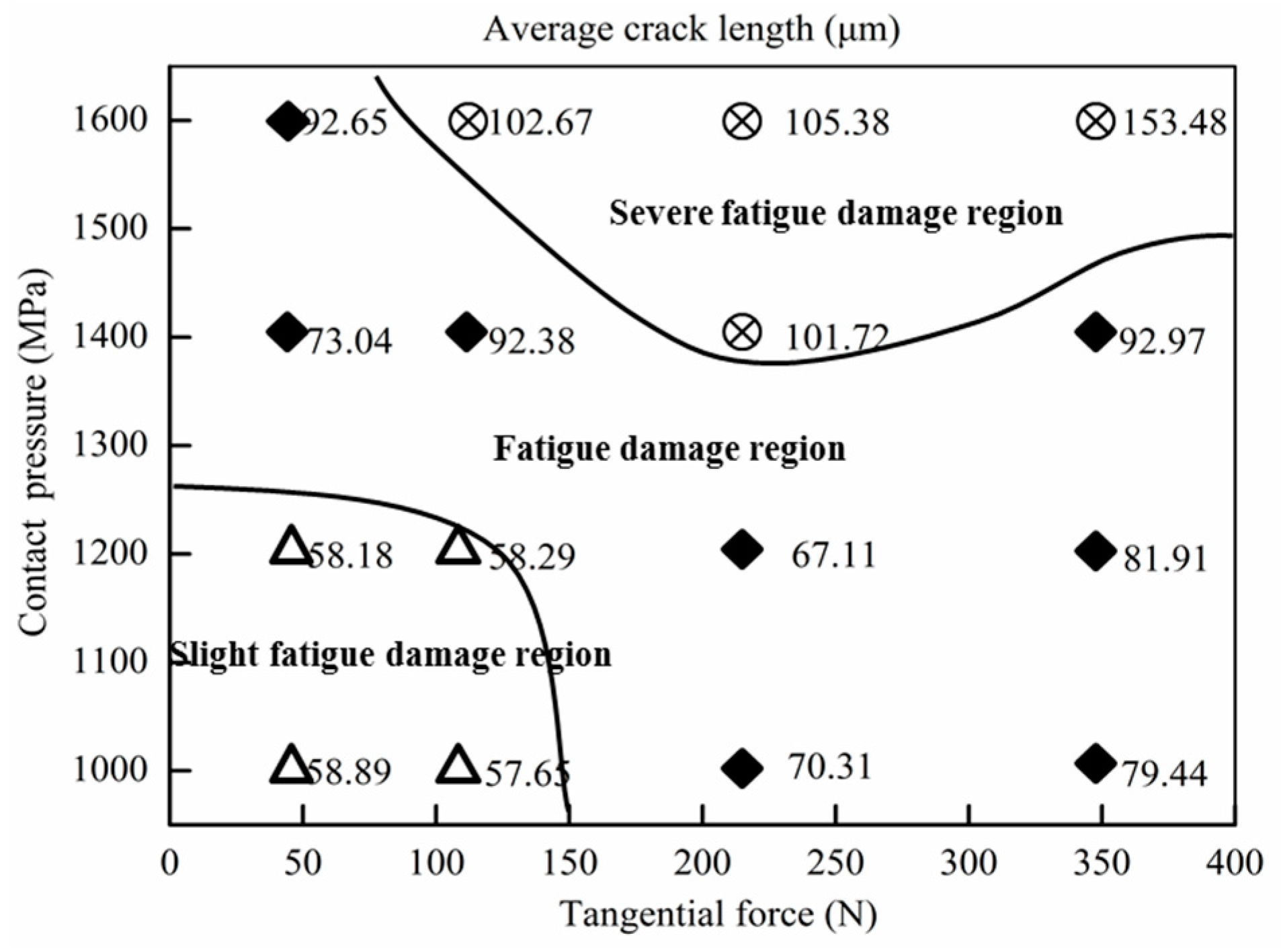
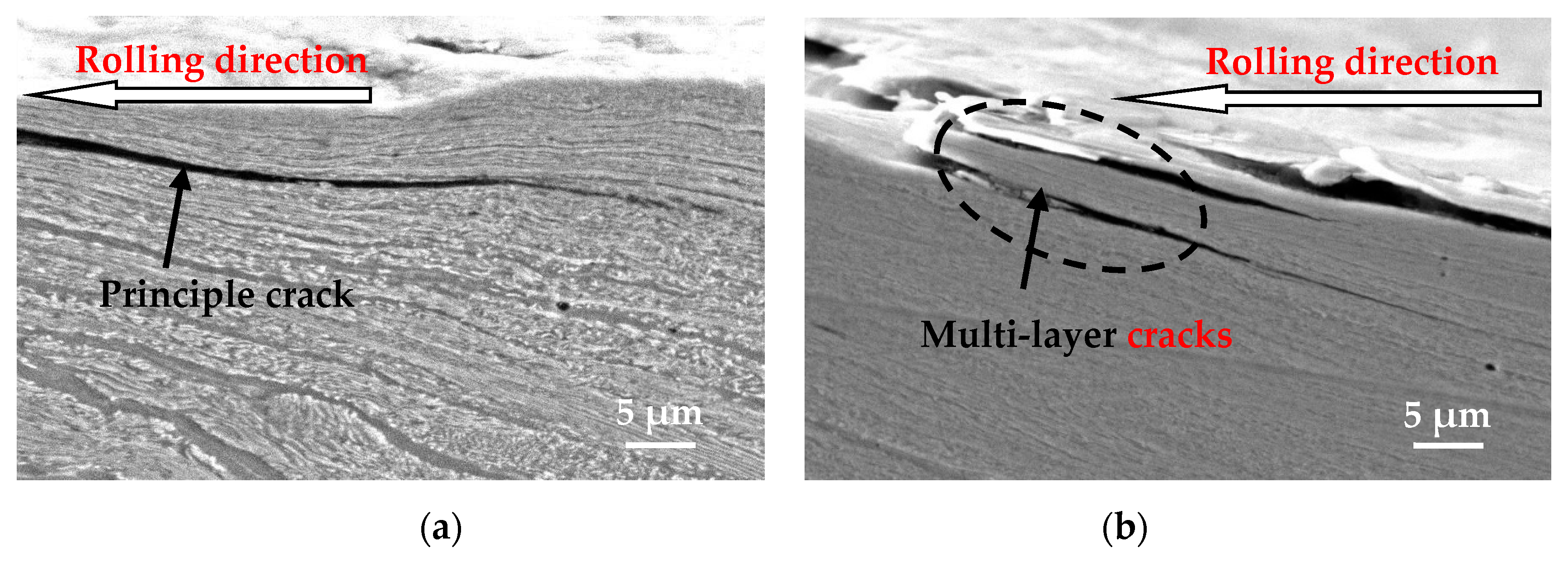
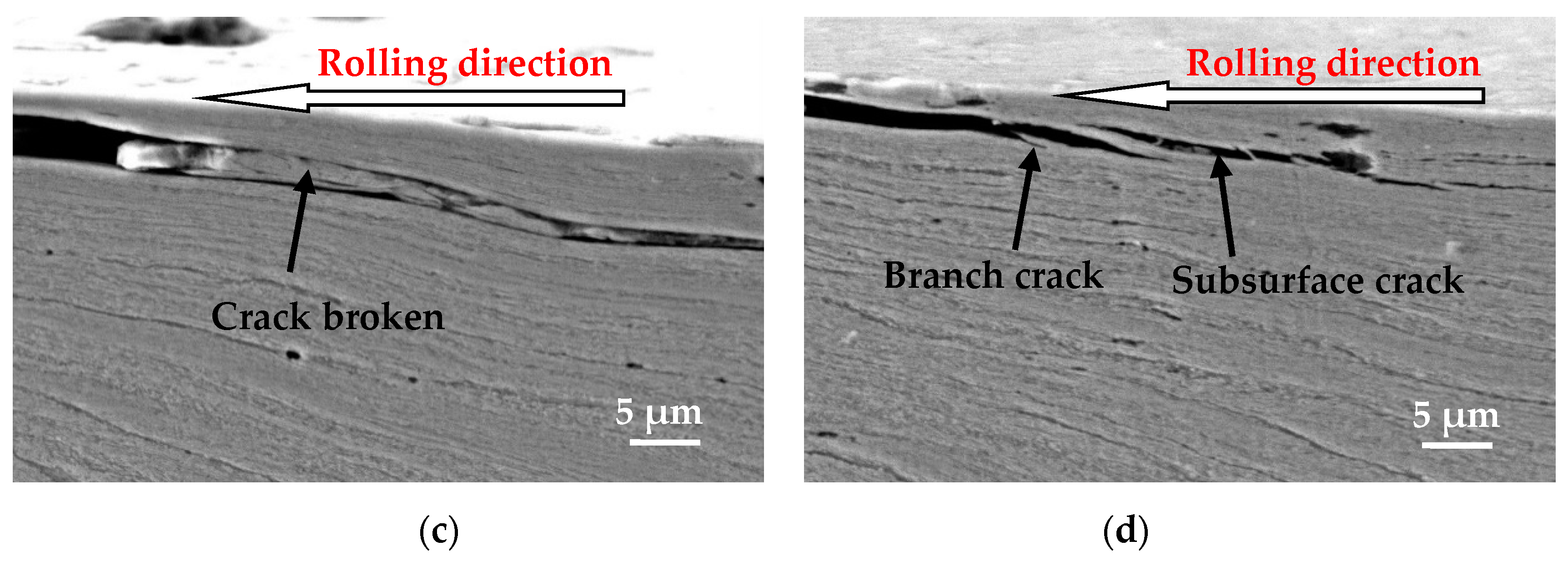
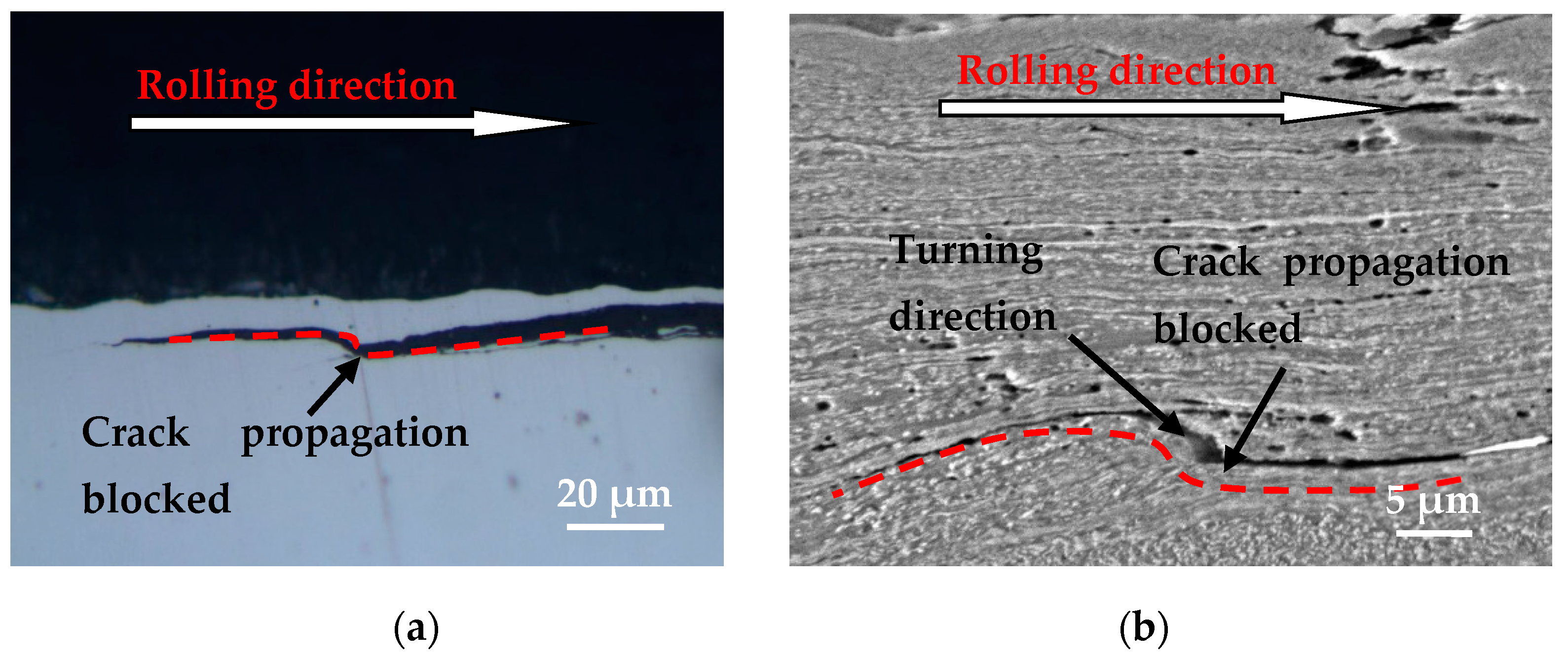
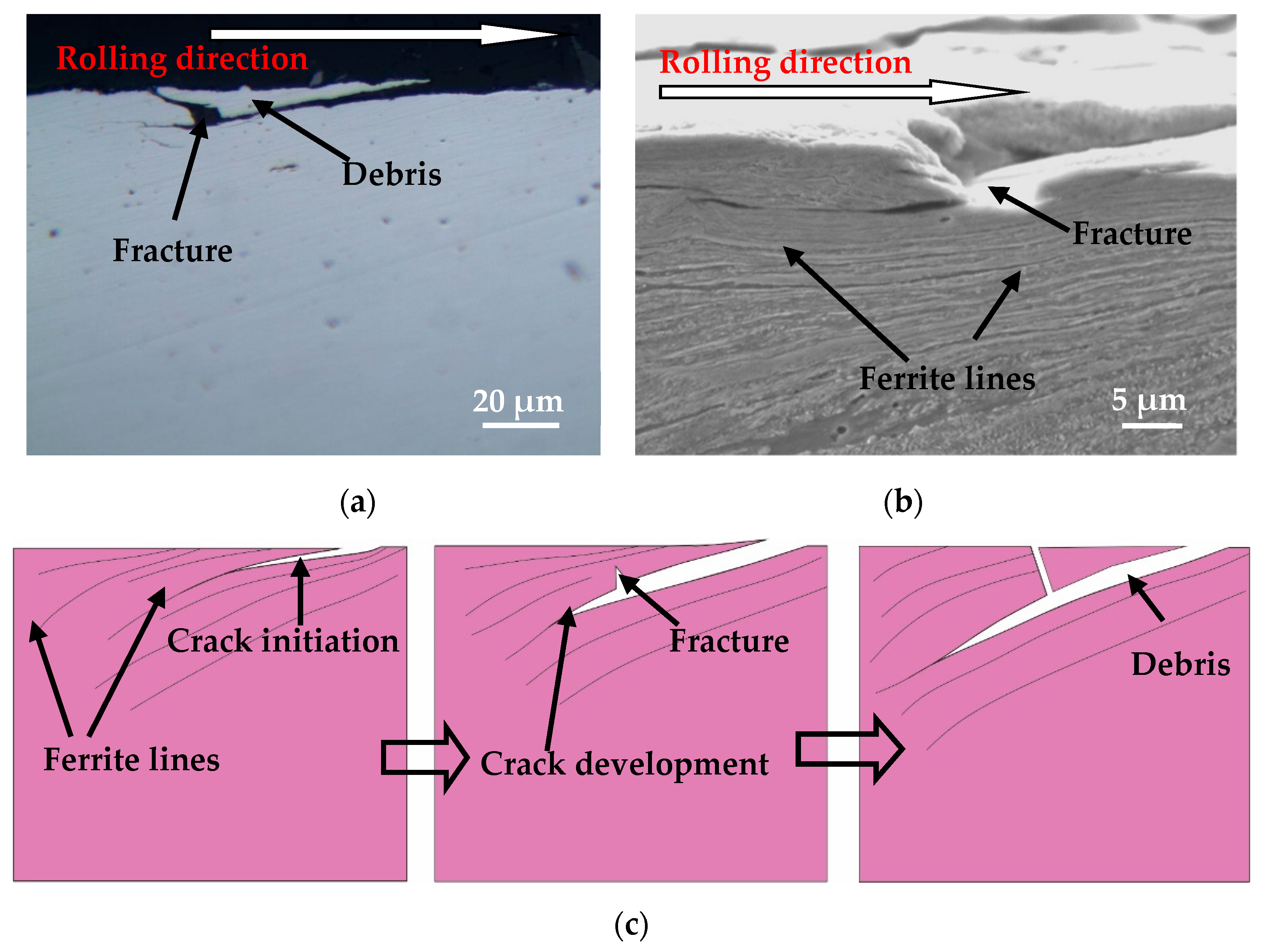
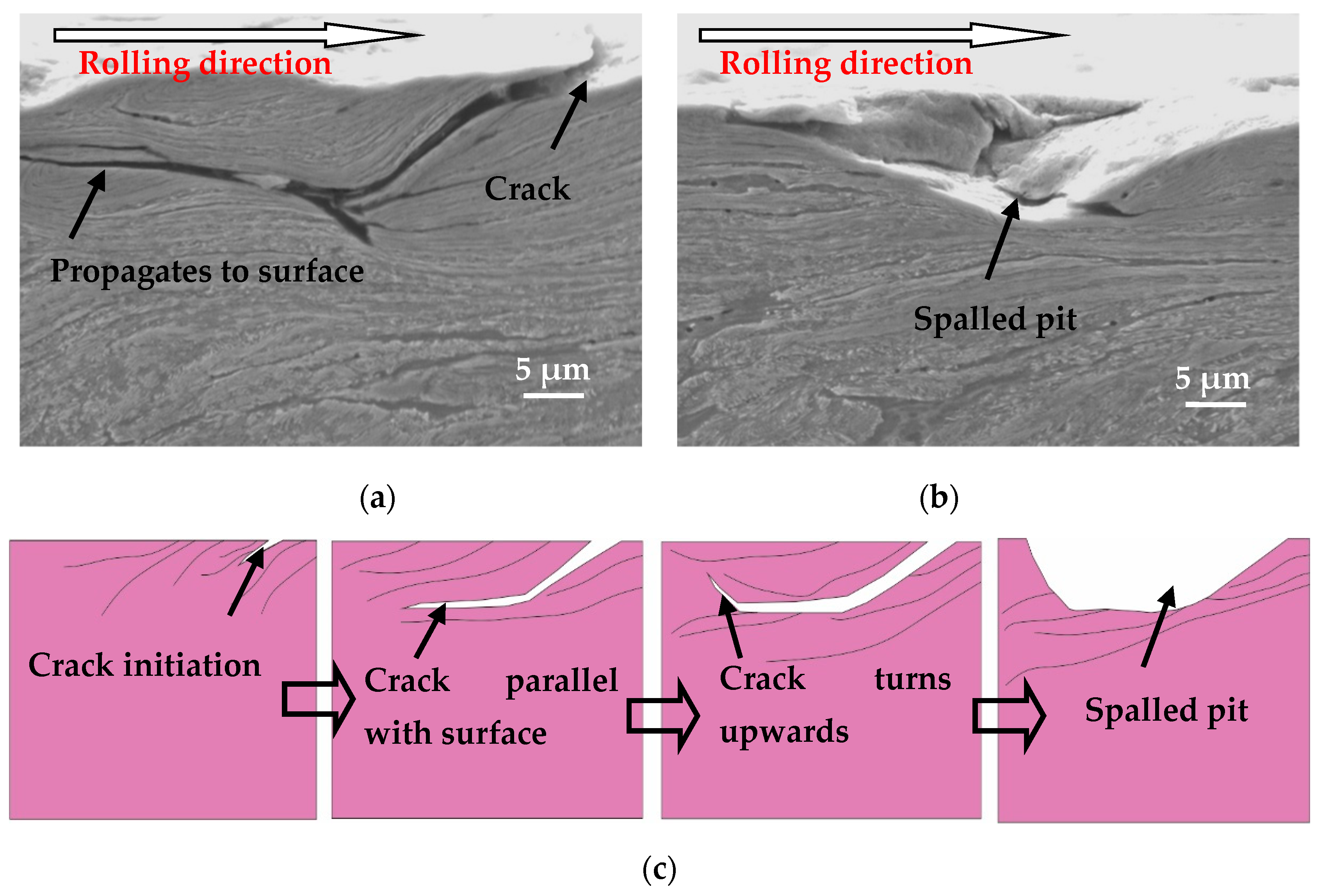
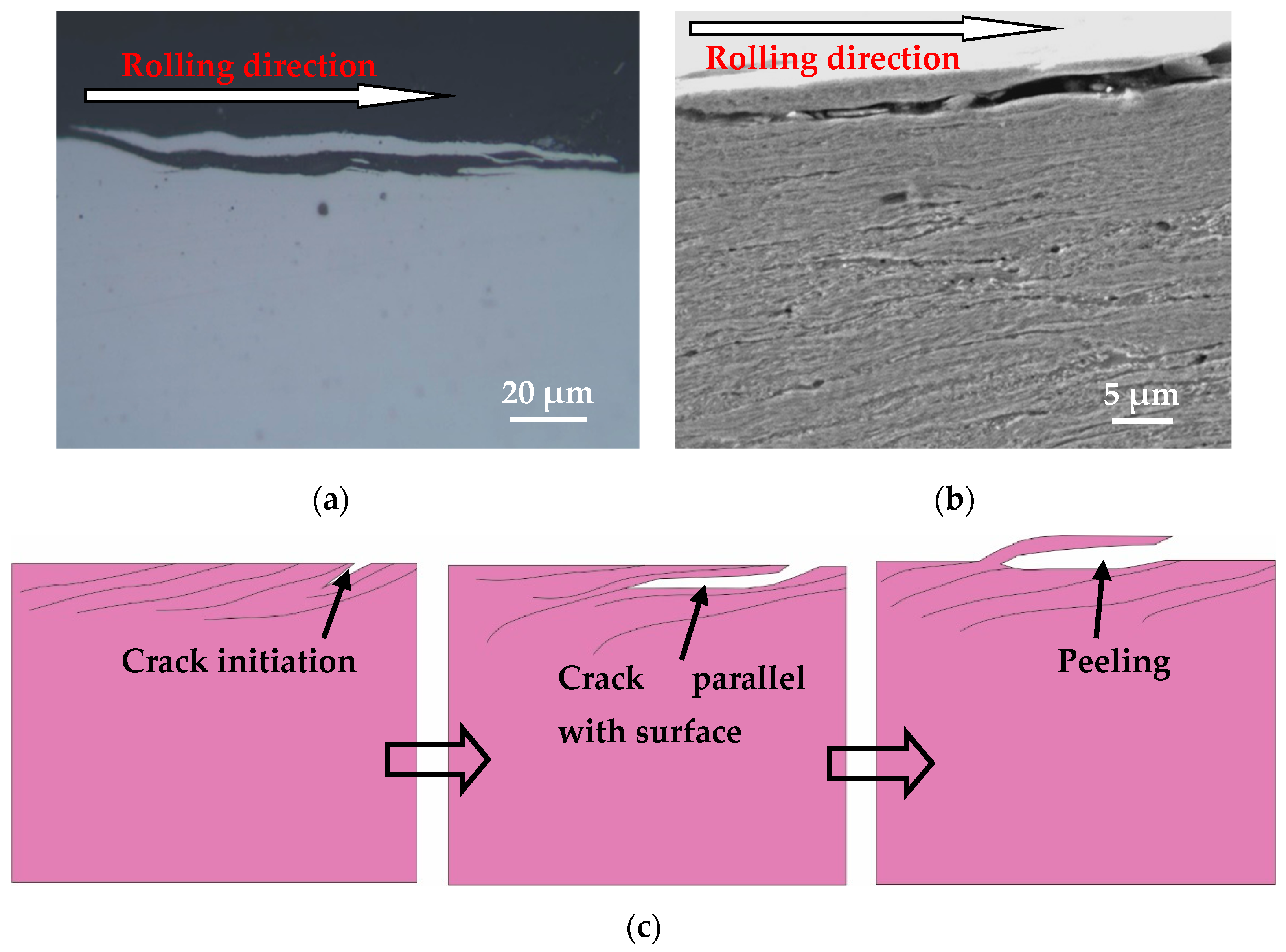
| Materils | Chemical Composition (wt%) | The Main Mechanical Properties | ||||||
|---|---|---|---|---|---|---|---|---|
| C | Si | Mn | P | S | σb (MPa) | δ10(10%) | Hardness (HV0.5) | |
| Wheel | 0.56–0.60 | ≤0.40 | ≤0.80 | ≤0.020 | ≤0.015 | ≥880 | ≥10 | 280 |
| Rail | 0.65–0.75 | 0.10–0.50 | 0.80–1.30 | ≤0.025 | 0.008–0.025 | ≥900 | ≥10 | 300 |
| Test Number | Contact Pressure | Tangential Force | Test Number | Contact Pressure | Tangential Force |
|---|---|---|---|---|---|
| TN1 | 1000 MPa | 40 N | TN9 | 1000 MPa | 220 N |
| TN2 | 1200 MPa | 40 N | TN10 | 1200 MPa | 220 N |
| TN3 | 1400 MPa | 40 N | TN11 | 1400 MPa | 220 N |
| TN4 | 1600 MPa | 40 N | TN12 | 1600 MPa | 220 N |
| TN5 | 1000 MPa | 110 N | TN13 | 1000 MPa | 350 N |
| TN6 | 1200 MPa | 110 N | TN14 | 1200 MPa | 350 N |
| TN7 | 1400 MPa | 110 N | TN15 | 1400 MPa | 350 N |
| TN8 | 1600 MPa | 110 N | TN16 | 1600 MPa | 350 N |
© 2019 by the authors. Licensee MDPI, Basel, Switzerland. This article is an open access article distributed under the terms and conditions of the Creative Commons Attribution (CC BY) license (http://creativecommons.org/licenses/by/4.0/).
Share and Cite
He, C.; Liu, J.; Wang, W.; Liu, Q. The Tribo-Fatigue Damage Transition and Mapping for Wheel Material under Rolling-Sliding Contact Condition. Materials 2019, 12, 4138. https://doi.org/10.3390/ma12244138
He C, Liu J, Wang W, Liu Q. The Tribo-Fatigue Damage Transition and Mapping for Wheel Material under Rolling-Sliding Contact Condition. Materials. 2019; 12(24):4138. https://doi.org/10.3390/ma12244138
Chicago/Turabian StyleHe, Chenggang, Jihua Liu, Wenjian Wang, and Qiyue Liu. 2019. "The Tribo-Fatigue Damage Transition and Mapping for Wheel Material under Rolling-Sliding Contact Condition" Materials 12, no. 24: 4138. https://doi.org/10.3390/ma12244138
APA StyleHe, C., Liu, J., Wang, W., & Liu, Q. (2019). The Tribo-Fatigue Damage Transition and Mapping for Wheel Material under Rolling-Sliding Contact Condition. Materials, 12(24), 4138. https://doi.org/10.3390/ma12244138





